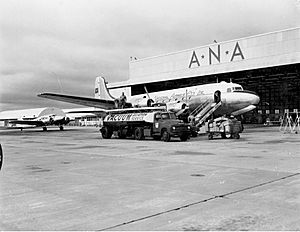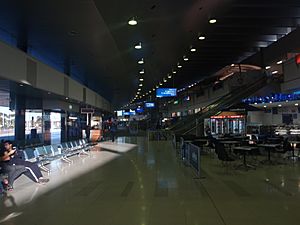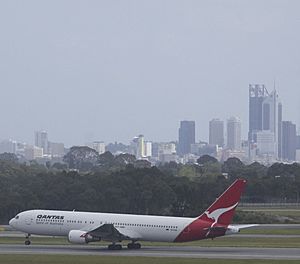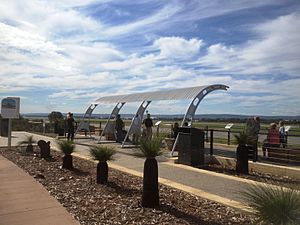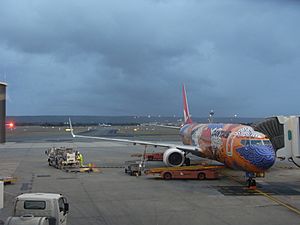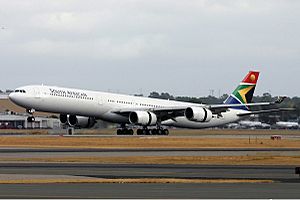Perth Airport facts for kids
Quick facts for kids
Perth Airport
|
|||||||||||||||
|---|---|---|---|---|---|---|---|---|---|---|---|---|---|---|---|
 |
|||||||||||||||
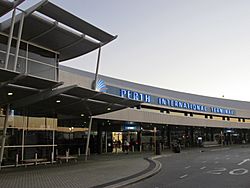
Terminal 1 in 2015
|
|||||||||||||||
| Summary | |||||||||||||||
| Airport type | Public | ||||||||||||||
| Owner | Utilities Trust of Australia (38%) Future Fund (30%) |
||||||||||||||
| Operator | Perth Airport Pty Ltd | ||||||||||||||
| Serves | Perth Metropolitan Region | ||||||||||||||
| Location | Perth Airport | ||||||||||||||
| Hub for |
|
||||||||||||||
| Focus city for | |||||||||||||||
| Elevation AMSL | 67 ft / 20 m | ||||||||||||||
| Coordinates | Lua error in Module:Coordinates at line 614: attempt to index field 'wikibase' (a nil value). | ||||||||||||||
| Map | |||||||||||||||
| Lua error in Module:Location_map at line 416: Malformed coordinates value. | |||||||||||||||
| Runway | |||||||||||||||
|
|||||||||||||||
| Statistics (YE June 2016) | |||||||||||||||
|
|||||||||||||||
Perth Airport (IATA: PER, ICAO: YPPH) is an international airport serving Perth, the capital city of Western Australia.
It is the fourth busiest airport in Australia measured by passenger movements and falls within the boundaries of the City of Belmont, City of Kalamunda and the City of Swan. Perth Airport and Jandakot Airport, the other civilian airport within the Perth metropolitan area, recorded a combined total of 362,782 aircraft movements in 2017.
Since 1997, it has been operated by Perth Airport Pty Ltd under a 99-year lease from the Commonwealth Government.
Contents
Locations
Terminal 1 is utilised by all international services from perth on the northern flank, with the western flank being used by Virgin Australia for its domestic services, with Terminal 2, which is used for non-Qantas-related intrastate flights located to its south. The group is 17 km (11 mi) from Perth. The main access road is Airport Drive, replacing Horrie Miller Drive as the main access road on 13 April 2015..
The Jetstar and Qantas terminals (known as Terminal 3 and Terminal 4), are also side by side at the western edge of the airport and about 12 km (7.5 mi) from the Perth CBD. The main access road is Dunreath Drive, replacing Brearley Avenue as the main access road in 2017 after the latter was closed for works developing the Forrestfield-Airport Link.
The two terminal groups are located separately, 11 km (6.8 mi) apart, with both Airport and Dunreath Drives being connected to each other via interchanges on the Tonkin Highway. Prior to this, Dunreath Drive used to extend to Horrie Miller Drive, providing the internal link between the two buildings.
History
Early days
Prior to the opening of the Perth Airport, civilian air services for the city were provided from Maylands Airport located in Maylands (in operation since 1924), as well as on the city's foreshore at Langley Park. By the end of the 1930s, it became clear that the Maylands Aerodrome was limited in the size and speed of aircraft it was able to handle thus causing them to seek an alternative site for a future airport.
Site selection and preparation of the original plans was undertaken by Mr N M Fricker of the Department of Civil Aviation. In 1938, land was selected and purchased for the new aerodrome. The site selected in what was at the time Guildford, was an area of land granted by Governor James Stirling to local man John Scott, which later became the long disused Dunreath Golf Course.
A plaque located on a roadside wall of the old International terminal remains in permanent memory of Scott:
Perth Airport stands on part of an area granted originally by Governor James Stirling to John Scott. A yeoman farmer from Lanarkshire, Scotland who arrived in Western Australia in March 1831, after a voyage of about 90 days in the schooner Eliza of 343 tons. He came at the invitation of the governor, to establish and maintain a bloodstock farm for the colony. He made his home near Guildford, using the Swan River to reach the farm in this area.
In recognition of his services Governor Stirling granted him lease of an area at Bunbury, where he became the first settler in 1838.
Remember him as one who helped to bring prosperity to this land.
Military operations
Even before civil aviation operations could commence at the new site, the onset of World War II saw the facility being redesigned for military purposes as a temporary base for the Royal Australian Air Force and United States Navy, known as "RAAF Station Guildford", primarily to supplement RAAF Base Pearce. Royal Australian Air Force No. 85 Squadron was based there from February 1943.
Despite military use of the airfield, civil services operated by Qantas Empire Airways and Australian National Airways (ANA) commenced from the location in 1944. This was despite bitter protest from military authorities who felt civilian operations would undermine the defence and camouflage needs of the location.
The move was agreed to by the government of the day, as the larger types of aircraft of the day being operated by the two airlines could simply not be handled at Maylands, notwithstanding the small grass airfield, lack of passenger facilities, and approaches being difficult due to surrounding industrial infrastructure. Using Douglas DC-3 aircraft, ANA flew the first commercial service from the aerodrome to Adelaide. On 17 June 1944, Qantas made its inaugural flight to Ceylon via Exmouth using a modified Liberator bomber, arriving in Perth on 3 June 1944 having been released to the airline by the British Government.
Early civilian operations
Full civilian operations at the Guildford Aerodrome commenced in 1944. Civil operations at Maylands continued albeit reduced until 30 June 1963, when the airport closed and its function as a secondary airport was taken over by Jandakot Airport the very next day.
The Guildford Aerodrome as it was then known was at best only a basic airfield. On a large open airfield with plenty of space, an unobtrusive control tower was hidden away amongst a collection of buildings inherited from the wartime operations at the site. The then Department of Civil Aviation inherited a large number of operating vehicles from the former military occupants, including an assortment of vehicles including "Blitz" wagons, Dodge command cars and weapon carriers, large trucks and various makes of fire tenders, jeeps and ambulances. Boarding aircraft at Guildford was described as being a bit like boarding a bus given the lack of passenger facilities at the time.
In 1948, the Horrie Miller owned MacRobertson Miller Aviation Co. (MMA) relocated from Maylands to Guildford. followed by newly formed government airline Trans Australia Airlines (TAA) on 2 December of that same year, operating Douglas C-54 Skymasters on its Perth – Melbourne – Sydney route. Due to the lack of road transportation across the Nullarbor Plain, it was at this time that Guildford became the scene of very busy cargo operations. Fresh fruits, vegetables, and manufactured goods were being flown from east to west and back again.
The airport only received international status and was renamed to Perth International Airport in 1952. Officiated by the then Federal Minister for Civil Aviation, Hubert Anthony, the official ceremony for the renaming took place on the main apron in front of a converted Bellman hangar used by TAA as their passenger terminal. At the time, a new international terminal building was under construction but had not been completed in time for the ceremony. This new terminal was being constructed using steel and cladding recycled from American-built military quonset buildings being dismantled and shipped over from Manus Island.
It was also on this day that Qantas commenced its Wallaby service using the Constellation Charles Kingsford Smith" (VH-EAD) from Sydney to South Africa via Western Australia, the Cocos Islands, and Mauritius.
The jet age
Towards the mid-1950s, airline travel was still being used by only a small percentage of the population. At that time, only 8% of the population had ever flown, but as the marketplace evolved, so did the types of people and their reasons for flying.
It was at this time the airport began to experience the full effects of the jet age. Although both Air India and Qantas commenced operating Boeing 707s in the mid to late 1950s from Perth to Singapore and the sub continent the aircraft of the day grew faster and more demanding due to their sophistication, facilities at the airport continued to improve to accommodate them. By the mid-1960s the airport commenced seeing its first domestic pure jet engine aircraft, commencing with a Boeing 727 in 1964, and the Douglas DC-9 in 1967, both types operated by TAA and Ansett ANA. It was at this time that the airport was one of the few major airports in the country which operated without curfews, and due to the increased number and frequency of flights operating from the airport it gave birth to what was then referred to as the midnight horror or red-eye special, known in more recent history as the red-eye flight.
Demise of the hangar terminals
In 1960, the current international terminal previously constructed from steel and cladding from Manus Island was dismantled and then re-erected in the suburb of Cannington. Known as The Alco Building, it was re-designed for use as a commercial facility.
The removal of the steel structure made way for the construction of an entirely new combined domestic and international passenger terminal, constructed on the northern side of the airfield. It was in 1962 that airlines were able to move from their hangars into a new combined passenger terminal, designed by the Commonwealth Department of Works and opened just in time to handle 1962 British Empire and Commonwealth Games traffic increases. The new combined terminal was opened that same year by then Minister for Civil Aviation, Senator Shane Paldridge; it was located in an area positioned between Terminals 3 and 4 and is currently used as the crew base for both Qantas and Skywest, and offices for airlines and support firms.
International terminal development
From 1962 onwards, both the domestic and international passenger operations at the airport were provided by a single terminal. However, by the arrival of the Boeing 747 on 3 September 1971, the existing terminal had reached its capacity, and modelling of future passenger numbers showed it would be unable to handle any further increases in passenger demand.
In November 1980, the Federal Transport Minister, Ralph Hunt, announced that a new international terminal would be built in Perth at a cost of A$26 million (1980). Design of the new International Terminal commenced in 1982, with one of the key principles of the design being the allowance for easy future expansion as the needs of the airport dictated. The project called for the construction of a new terminal, apron, airside roads, access roads, car parks and other passenger facilities.
Construction of the new International Terminal and control tower commenced in March 1984 on the south-eastern side of the airfield. In 1984, the road leading to the new terminal, Horrie Miller Drive was named in honour of local aviation pioneer Horrie Miller. The terminal was officially opened on 25 October 1986 by then Prime Minister Bob Hawke, with the new terminal receiving passengers just days after. The newly built control tower was the tallest in Australia at its time of construction, and remains to be the tallest in Australia.
Upon completion, the terminal was able to process up to five Boeing 747 aircraft per hour and accommodated a peak passenger volume of 6,000 passengers per hour. Twenty years later, in the 12 months to June 2006 the terminal processed over 2.027 million passengers, surpassing a 1996 projection of 1.016 million passengers in that period.
1988 onwards
In the late 1980s the Federal Government, as a prelude to eventual privatisation, formed the Federal Airports Corporation (FAC). In 1988, FAC took over as manager of Perth Airport (and many other Australian airports).
At this time also, airline operators Qantas and Ansett set about on ambitious capital works programs to construct new domestic terminals for their respective airlines on the northern side of the terminal, where they still stand to this day.
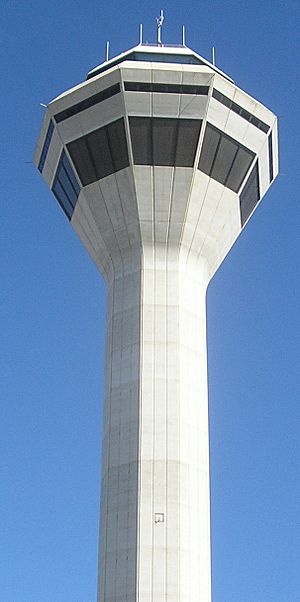
In 2001, after the financial collapse of Ansett, the Ansett terminal became a multi-user terminal, catering for flights from former Ansett-subsidiary Skywest, as well as Virgin Australia and now charter airlines including Alliance Airlines and previously Strategic Airlines (traded as Air Australia).
From 2003 to 2004, the International terminal underwent major internal refurbishments to provide an increased array of passenger services, including increased space for duty-free stores and food and beverage concession stands. Further upgrades valued at $25 million (2006) were made to the terminal across 2005 and 2006 which added an additional 2,500 m² of floor space, additional check-in counters, and an improved baggage handling and screening system.
The airport commemorated its 60th anniversary in 2004, with an event that opened the new Taxiway Sierra, a new taxiway supporting larger aircraft such as the Boeing 747, Airbus A340, and potentially the Airbus A380 to operate at the airport.
On 11 October 2007, Perth International Airport received the first test flight out of Terminal 3 at Changi International Airport, Singapore. The test flight was a Singapore Airlines flight that departed Changi Airport at 5:30 pm, landing in Perth at 11:30 pm.
On 14 October 2008, the Airbus A380 made its first visit to the airport as a part of the Qantas A380 promotional tour around Australia. The second A380 to visit the airport was an Emirates aircraft which made an emergency landing on 15 August 2009, after a passenger on the Dubai to Sydney flight suffered a stroke.
On 1 February 2013, Qatar Airways was due to commence the first commercial service of the Boeing 787 Dreamliner aircraft into Australia on its daily services from Perth to Doha. However, due to the worldwide grounding of the 787 this was delayed indefinitely. In 2016, Qatar has since stated that it intends to introduce the Airbus A350 aircraft on flights to Perth once they receive enough of the aircraft.
Philippine Airlines commenced flights from Manila to Perth on 2 June 2013, but were later withdrawn in September 2013.
Emirates were to start the first Airbus A380 service to Perth from Dubai in early 2014 when the construction of a dual level boarding gate and other expansions to the terminal, including a new Emirates business class lounge, are completed. Emirates was originally scheduled to commence A380 operations in late 2013, however in June 2013 the airport revealed a 5-month delay in the terminal expansion project. While the A380 gate complex itself is due to be completed in November 2013, the airport will not have the capacity to facilitate A380 operations until the other upgrades are completed in March 2014. However, on December 16, 2014, Emirates announced that they will commence A380 operations to Perth in May 2015 with one of its three daily flights. As of the 1st of August, the remaining Emirates Boeing 777-300ER service, will be replaced with an Airbus A380, tallying the total Emirates A380 daily services to two.
On 15 May 2016, the world's largest commercial jet airliner, the Antonov An-225 Mriya landed at Perth Airport, making its first visit to Perth and Australia.
On 11 December 2016, Qantas announced that they would commence non-stop flights from Perth to London Heathrow in March 2018 with one of their newly acquired Boeing 787 Dreamliners. To achieve this the Qantas domestic terminal at T3/T4 would be upgraded during 2017 to cater for international flights. Once completed the existing Qantas flights to Singapore and Auckland will also migrate to the same terminal.
Airlines and destinations
As of November 2015, Perth Airport is served by 34 scheduled airlines flying to over 50 destinations. The following carriers operate to the following destinations: A total of 1258 scheduled domestic and regional flights arrive and depart from Perth Airport each week. On the international front, a total of 213 scheduled international flights arrive and depart from Perth Airport each week.
Passenger
| Airlines | Destinations | Terminal |
|---|---|---|
| AirAsia X | Kuala Lumpur–International | 1 |
| Air Mauritius | Mauritius | 1 |
| Air New Zealand | Auckland Seasonal: Christchurch |
1 |
| Airnorth | Seasonal: Darwin, Kununurra | 4 |
| Alliance Airlines | Charter: Barimunya, Christmas Creek, Condewanna, East Jaurdi, Kalgoorlie, Karratha, Leinster, Leonora, Mount Keith, Newman, Paraburdoo, Port Hedland, Telfer, The Granites | 2 |
| Cathay Pacific | Hong Kong | 1 |
| China Southern Airlines | Guangzhou | 1 |
| Cobham | Charter: Barrow Island, Kambalda, Granny Smith, Murrin Murrin | GA |
| Emirates | Dubai-International | 1 |
| Etihad Airways | Abu Dhabi | 1 |
| Garuda Indonesia | Denpasar, Jakarta-Soekarno-Hatta | 1 |
| Indonesia AirAsia | Denpasar | 1 |
| Jetstar Airways | Adelaide, Cairns, Gold Coast, Melbourne, Sydney | 3 |
| Jetstar Airways | Denpasar, Singapore | 1 |
| Jetstar Asia Airways | Singapore | 1 |
| Malaysia Airlines | Kota Kinabalu, Kuala Lumpur–International | 1 |
| Malindo Air | Kuala Lumpur–International | 1 |
| Maroomba Airlines | Mount Magnet | GA |
| Qantas | Adelaide, Alice Springs, Brisbane, Canberra, Darwin, London-Heathrow (resumes 1 March 2018), Melbourne, Sydney | 4 |
| Qantas | Singapore Seasonal: Auckland |
1 |
| QantasLink operated by Network Aviation |
Broome, Exmouth, Geraldton, Kalgoorlie, Karratha, Newman, Paraburdoo, Port Hedland Charter: Christmas Creek, Cloudbreak, Coyote, Ginbata, Leinster, Morawa, Solomon || align="center" | 4 |
|
| Qatar Airways | Doha | 1 |
| Regional Express Airlines | Albany, Esperance | 2 |
| Scoot | Singapore | 1 |
| Singapore Airlines | Singapore | 1 |
| Skippers Aviation | Burnakura, Darlot-Centenary, Carnarvon, Jundee, Kalbarri, Laverton, Lawlers, Leinster, Leonora, Meekatharra, Monkey Mia/Shark Bay, Mount Magnet, Plutonic, Sunrise Dam, Wiluna | GA |
| South African Airways | Johannesburg-O.R. Tambo | 1 |
| Thai Airways | Bangkok-Suvarnabhumi | 1 |
| Tigerair Australia | Brisbane (begins 1 June 2017) Melbourne, Sydney | 2 |
| Virgin Australia | Adelaide, Brisbane, Christmas Island, Cocos (Keeling) Islands, Darwin, Karratha, Newman, Melbourne, Port Hedland, Sydney | 1 |
| Virgin Australia Regional Airlines | Broome, Geraldton, Kalgoorlie, Karratha, Kununurra, Onslow, Paraburdoo, Port Hedland | 2 |
- Qantas' International services will move to T4 in 2018.
Cargo
Many major cargo airlines operate to Perth Airport as Charter Flights. These include: Singapore Airlines Cargo, MAS Cargo, Emirates SkyCargo, Korean Air Cargo and Atlas Air.
| Airlines | Destinations |
|---|---|
| Australian airExpress | Melbourne |
| Toll Priority | Brisbane, Melbourne |
Charter and mining airlines
These airlines provide regular charters for mining companies in Western Australia:
- Ad Astral Aviation
- AvWest
- Cobham
- Formula Aviation
- Maroomba Airlines
- Network Aviation
- Skippers Aviation
- Virgin Australia Regional Airlines
- Star Aviation
- Casair
Facilities and services
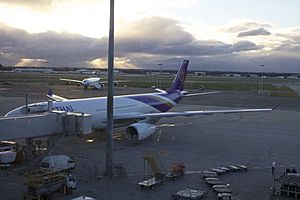
Perth Airport has four main terminals and one minor terminal:
- On the eastern side of the airport (location of the future consolidated terminal precinct) is,
- Terminal 1 (T1), the international terminal, caters for flights originating or departing outside Australia, with five jetways and a total of eight gates including a Multi Access Ramp System which allows dual boarding of aircraft including the Boeing 777 and Airbus A380. The international terminal has also supported upstart domestic airlines such as Compass Airlines in the 1990s, and Virgin Australia from 2001 to 2002. The latter airline later opened a domestic pier on the western end of T1 on the 22 November 2015. The exclusive home of Virgin Australia, it has 12 new gates and 14 check-in counters, some of which will be shared with international capabilities. There are currently three airline lounges. The Emirates lounge, Singapore Airlines Silver Kris lounge and Qantas Captains Club. The Emirates lounge has recently undergone a revamp, which involves a second level and offer direct boarding on their flagship Airbus A380 aircraft. It has been incorporated into the international terminal's ongoing departures expansion project.
- Terminal 2 (T2), is located to the immediate south west of T1. Virgin Australia Regional and Alliance commenced operations from the terminal on 2 March 2013, while Tiger moved its operations there on 23 April 2013. Regional Express Airlines will utilise Terminal 2 when the airline begins services on 28 February 2016 to Esperance and Albany.
- On the western side of the airport is the domestic terminal building, which is divided into two terminals,
- Terminal 3 (T3) has five jetways and a total of nine gates. Since 23 November 2015, it is currently used by Jetstar, although some Qantas services also operate from the terminal. It was the previous location for Virgin Australia and had a recently expanded member lounge, which utilised the space from the former Ansett Golden Wing Club / Alliance Airlines Lounge. The Qantas Group has exclusive use of both T3 and T4 since the movement of Virgin Australia to T1.
- Terminal 4 (T4), the Qantas terminal, is operated by Qantas Group and is dedicated to the domestic operations of Qantas, QantasLink & their budget subsidiary Jetstar. The terminal has four jetways and a total of nine gates. It has two member lounge, The Qantas Club, which was expanded in March 2013 to cater for an additional 140 passengers and the Qantas Domestic Business Lounge, which opened on 26 August 2014. The Perth Airport master plan outlines these terminals will ultimately be demolished and replaced by new domestic facilities east of T1.
- A northern general aviation terminal, used primarily by charter aircraft, mainly for mining companies as fly-in fly-out services to remote operations.
Runways
Flights are serviced by two runways – the main 03/21 runway, 3,444 m × 45 m (11,299 ft × 148 ft) and 06/24, 2,163 m × 45 m (7,096 ft × 148 ft).
After a 10-month project, a reconstructed cross runway was opened on 21 October 2005. The upgrades involved significant strengthening works and enlargement of turning nodes to accommodate regular operations by wide bodied aircraft, including the Airbus A380.
Meteorological services
Meteorological services for Perth Airport commenced in May 1944, provided by the Guildford Meteorological Office situated at Ivy St, Redcliffe.
In March 1988, surface observations were moved to the recently vacated old airport tower on the northern side of the airfield (near what is now Terminal 3). The Ivy Street location was retained for a time for radar services and the launching and tracking of weather balloons. In October 1997, all operations from the Ivy Street Office and Old Control Tower were transferred to a newly constructed office on the Northern Perimeter Road in Belmont, in the north-eastern corner of the airfield.
Landing patterns and approach
Perth Airport resides within the Melbourne FIR, which is managed by Melbourne Centre and operated by Airservices Australia.
Perth Approach Control then guides the aircraft to their final approach. Once an aircraft is established on its final approach, control is handed over to Perth Tower.
Transport
Road access to Terminals 3 and 4 from the CBD is via Tonkin Highway and Dunreath Drive. Terminals 1 and 2 are accessed via Tonkin Highway and Airport Drive. All terminals are serviced by a number of private charter bus operators that can be normally accessed through most major CBD hotels. Transperth operate route 935 to Kings Park via Belmont Forum and Perth City, and route 40 to the Elizabeth Quay Bus Station via the Great Eastern Highway and Victoria Park bus station, both from Terminal 4, and route 380 to Perth City via Belmont Forum from Terminal 1. The airport is not currently serviced by rail, however the construction of the Forrestfield-Airport Link will connect the airport to the Midland Line. Construction is scheduled to commence in 2016, with the line opening in 2020.
Observation areas
There are two dedicated spotting areas at Perth Airport. The T1 International Terminal houses an Observation Deck on Level 3 to view departing and arriving aircraft. It has vending machines, toilets and FIDSs.
The second spotting area is to the west side opposing the threshold of Runway 03 located along Dunreath Drive. The public viewing area has a shelter in the shape of the body section of a Boeing 747, and displays of information about the history of aviation.
Other services
The Australian Transport Safety Bureau has its Perth regional office on Level 2 of the Hkew Alpha Building on the property of Perth Domestic Airport.
Since May 2014, terminals T1 International, T2 Regional and T3 Domestic have a free wi-fi connection currently powered by iiNet. It is accessible throughout the entirety of the departure and arrival areas. Currently, T4 Qantas Domestic also has a free-wifi service provided by Qantas.
The Royal Automotive Club of WA has a purpose-built driver training facility, which is the only one of its kind in the state at Perth Airport. It is located towards the east of the current T1 International Terminal on Grogan Road. The RAC Driving Centre is set on over thirty hectares of land.
Operations and statistics

Total
Total passengers using the airport has increased on average by 5.8% annually since 1998–99, with 70% of passenger traffic at the airport attributed to domestic travel.
| Year | Domestic | International | Total |
|---|---|---|---|
| 1998–99 | 3,222,957 | 1,453,914 | 4,676,871 |
| 1999–00 | 3,374,136 | 1,516,842 | 4,890,978 |
| 2000–01 | 3,554,930 | 1,607,385 | 5,162,315 |
| 2001–02 | 3,168,747 | 1,597,721 | 4,766,468 |
| 2002–03 | 3,615,822 | 1,573,543 | 5,189,365 |
| 2003–04 | 4,154,561 | 1,734,238 | 5,888,799 |
| 2004–05 | 4,579,101 | 1,945,686 | 6,524,787 |
| 2005–06 | 5,025,504 | 1,979,750 | 7,005,254 |
| 2006–07 | 5,785,370 | 2,191,721 | 7,977,091 |
| 2007–08 | 6,474,249 | 2,477,820 | 8,952,069 |
| 2008–09 | 6,759,279 | 2,599,969 | 9,359,248 |
| 2009–10 | 7,010,711 | 2,981,877 | 9,992,588 |
| 2010–11 | 7,644,447 | 3,245,081 | 10,889,528 |
| 2011–12 | 9,140,418 | 3,492,160 | 12,632,578 |
| 2012–13 | 9,990,727 | 3,763,677 | 13,664,394 |
| 2013–14 | 9,843,341 | 4,118,239 | 13,961,580 |
| 2014–15 | 9,790,464 | 4,193,740 | 13,984,204 |
Domestic
| Rank | Airport | Passengers | % change |
|---|---|---|---|
| 1 | Melbourne | 2,160,700 | |
| 2 | Sydney | 1,798,900 | |
| 3 | Brisbane | 1,062,000 | |
| 4 | Karratha | 695,200 | |
| 5 | Adelaide | 616,400 | |
| 6 | Port Hedland | 488,700 | |
| 7 | Newman | 369,000 | |
| 8 | Broome | 300,300 | |
| 9 | Kalgoorlie | 216,900 | |
| 10 | Darwin | 181,000 |
International
| Rank | Airport | Passengers handled | % Change |
|---|---|---|---|
| 1 | Singapore, Singapore-Changi | 1,061,213 | |
| 2 | Indonesia, Denpasar | 857,009 | |
| 3 | Malaysia, Kuala Lumpur–International | 497,833 | |
| 4 | United Arab Emirates, Dubai | 496,696 | |
| 5 | Hong Kong, Hong Kong | 226,649 | |
| 6 | Qatar, Doha | 196,836 | |
| 7 | New Zealand, Auckland | 195,044 | |
| 8 | United Arab Emirates, Abu Dhabi | 146,812 | |
| 9 | South Africa, Johannesburg | 138,238 | |
| 10 | Thailand, Bangkok-Suvarnabhumi | 121,114 |
Redevelopment plans
2024 Airport Master Plan
The 2024 airport master plan aims for the domestic and international terminals to be consolidated into a single terminal on the south-eastern side of the airfield sometime between 2021 and 2024. At present, the international and domestic terminals are on opposite sides of the airfield and are not directly connected through a regular public transport passenger service. While it is possible to travel by road between the two terminals, it is approximately an 11 kilometre (7 mi) distance between the two locations by public roads.
The 2024 master plan calls for the completion of a rail link that will connect with the Midland Line between Bayswater Station and Ashfield Station at the Tonkin Highway. The proposed rail link will continue above ground along Tonkin Highway to Great Eastern Highway where it is believed to go underground along Brearley Avenue and to the terminals in operation at completion of the line. A rail link to the airport was originally proposed in the 1990s by nearby local government bodies, however the proposal was not followed through at the time. In 2014, the rail link plan received its final approval from the state government, and is expected to be complete by 2020, with construction starting in 2016. The rail link however will be entirely underground, contradicting the original plan of it being partly underground and party above ground.
In 2008, Westralia Airports announced their intention to complete a A$1 billion upgrade project which addresses key elements of the masterplan. The announced plans will see the domestic and international terminal merge, as flagged within the original plans for the construction of the international terminal, a project likely to be completed within seven years.
2014 Airport Master Plan
Perth Airport is advancing on a number of new terminal developments which will ultimately see all international and domestic operations consolidated into the current T1 international terminal area, renamed Airport Central. It is anticipated to be completed around 2020.
Consequently, other key developments for the airport outlined in the master plan include the construction of a new International Pier at the eastern end of T1, T2 being progressively expanded to meet demand, a new domestic terminal to be located to the east of the current T1 building – in the final stage of the consolidation of all commercial air services, construction of a new runway, building multi-storey car parks and commercial office space and significant upgrades to airport roads, including passenger access via Airport Drive.
The construction of a third runway, parallel to the current 03/21 has also been brought forward due to "unprecedented growth" and is anticipated to be operational by the end of the decade.
The master plan also anticipates construction of the planned rail link to the airport with the authority committed to work with the government of Western Australia to finalise the route and station locations for the proposed Forrestfield-Airport rail link. The state government has planned that the rail link be operational in 2020.
Intrastate terminal: T2
The first phase of the masterplan involved the delivery of a facility formerly known as Terminal WA (now T2) which was officially opened on 28 February 2013, with the first flights operating out of the terminal on 2 March 2013.
Construction commenced during late 2011, with combined works to deliver the new terminal valued at $120 million (2010). This will significantly reduce activity in the domestic precinct, further improving the experience for Qantas and Virgin Australia customers and facilitating continued growth for these airlines.
The new single story terminal has been designed to provide;
- At-grade access to terminal building,
- 16 common use check-in counters, including space for self-service and bag drop technologies,
- Centralised passenger security screening zone,
- Three baggage reclaim belts,
- Dedicated pick-up and drop-off lanes at the front of the terminal,
- 14 aircraft bays, accessible from enclosed walkways and serviced by 8 boarding counters, and
- 36 additional aircraft parking bays.
Consideration of environmental needs has been planned into the building design, with systems including rainwater harvesting and re-use, and establishment of ventilation systems delivered below ground to reduce energy costs.
Current tenants: Tigerair Australia, Virgin Australia Regional Airlines and Alliance Airlines.
International terminal
Redevelopment of the international terminal has also commenced, scheduled for completion in 2014 at a cost of over $165 million. The redevelopment will include an expanded check-in hall, a refurbished departure area and an A380 gate, which Emirates used for the first time in 2015.
Virgin Australia domestic pier
The most significant of the three redevelopment projects is the new domestic pier located at T1, which will become the exclusive home to Virgin Australia. Virgin Australia's partner, Etihad Airways began daily direct services from its hub in Abu Dhabi on 16 July 2014. Transfers between domestic and international legs currently requires a 20-minute bus ride, the new pier will ensure quicker and more seamless transfers between the two airlines. The pier will also be connected to Terminal 2 via an elevated walkway allowing seamless transfer to Virgin's regional services without having to be re-screened. The pier opened on the 22nd of November.
Third runway
Consultation with airlines on the timing and design of the new runway is now largely complete. During the next two years, extensive community consultation will be undertaken and approvals will be sought in accordance with the Airports Act 1996. An additional period of approximately two years will be required to construct the new runway, assuming approvals are granted. The construction of the new runway (03R/21L) is scheduled for completion in 2019, subject to demand. The new runway will be 2,700 metres long and 45 metres wide, running parallel to the existing main runway and located between the current International Terminal (T1) and Abernethy Road. It is expected to be completed by 2019.
Images for kids
-
Ansett Boeing 727-100 at Perth Airport in 1971
-
The airport control tower, built in 1987
-
An AirAsia X aircraft
-
Afternoon lineup at Perth Airport (from front to back): Emirates Airbus A380, Scoot Boeing 787, Air New Zealand Boeing 787, Qatar Airways Boeing 777
See also
 In Spanish: Aeropuerto de Perth para niños
In Spanish: Aeropuerto de Perth para niños



